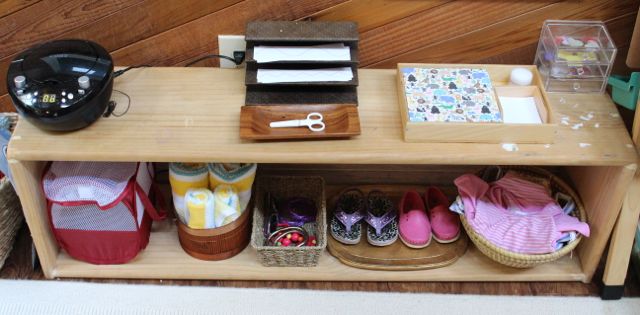Raising a Disciplined Child (Or At Least One Who Listens!)
B dancing in her swimsuit
Recently, I’ve been obsessively reading Montessori books. I came upon a whole chapter on discipline in The Discovery of the Child, which I loved.
“One of the greatest difficulties in securing discipline lies in the fact that it cannot be obtained simply with words,” Montessori writes. Okay, so that’s the bad news. You can’t make a child do something just by telling him to do it.
She writes, “To tell a child: ‘Stand still like me!’ does not enlighten him. One cannot by a simple command put order into the complex psycho-muscular system of a still growing individual.” Most of us think that if children aren’t doing what we ask because they are disobeying us, when in fact, most of the time, they are simply UNABLE to follow our commands. Their body and mind has not come together in such a way to be able to do what we ask, so our job then is to help them achieve this before expecting them to obey our commands.
Montessori breaks down obedience into three stages. In the first stage, the child cannot obey you. This child, usually between 0-2.5, is obeying the voice inside himself, you can also call it his ‘inner directive’ (if you know a toddler, then you know what she means). In the second stage, the child would like to obey and seems to understand your command and wishes to obey, but he cannot obey, or rather, he does not always succeed in obeying, even if he wants to. This stage starts from 2.5 and lasts till about 4.5-5 years old. In the third stage, the child has perfected his self-control and is able to do what you ask. This doesn’t mean he always will, but he is physically and emotionally capable of obeying. So before 5 years old, a child either cannot obey you or wants to but cannot do it well.
How often do you yell at your 5-and-under because you think they’re being bad on purpose?
So how do you help a child learn to obey? She continues to write, “The first glimmerings of discipline have their origin in work. At a certain moment a child becomes intensely interested in some task. This is shown by the expression on his face, his intense concentration, and his constancy in carrying out the same exercise. Such a child shows that he is on the way to becoming disciplined.”
Through work, the child is learning to bring together his body and mind, and through this process, he will achieve many things – one of which is being able to follow your commands.
So what can you do to help your child get here faster?
First, you need to observe your children closely and see what they are interested in. What do they like to do where they are not easily distracted? What tasks do they do with concentration and interest? Maybe they’re walking on that thin ledge on the sidewalk over and over. Maybe they’ve used up half the bottle of soap and still haven’t finished washing their hands. Maybe they’re putting on and taking off certain items of clothing over and over. Maybe they’re putting everything in their mouth and exploring. Well, until you’ve let them do those things over and over till they feel satisfied, getting them to do what you want them to do will be a struggle for you and them.
The hardest part of this whole thing is not letting your own judgments get in the way. Maybe you don’t think their interest is worthy, maybe it’s very inconvenient for you to let them, maybe you have other concerns that tell you not to let them do those things.
For example, it’s fall here in the Pacific NW and it is cold. But during this boots and jacket weather, Brooke (2 years 10 months old) spends more time putting on swimsuits than anything else. And it happens at the most inconvenient time. Like first thing in the morning when we are trying to get everyone out of the house by 730am. I’ve had to manhandle her out of her swimsuit into regular school clothes, with screams and tears, of course. She’s not interested in puzzles, learning her letters, painting or any of the myriad other activities I have out for her. No, she just wants to put on swimsuits – first the pink one, then the blue one, then the neon yellow one. And then all three, one on top of the other. It’s amazing how much time and concentration she spends on doing this everyday.
So this is what I decided to do.
On our work shelf, I created an activity called ‘going swimming.’ It includes everything you would need to go swimming, from swimsuits, t-shirts, shorts, flip flops, sunglasses, towels to tote bag. This is by far her favorite activity and four days later of almost nothing but changing into and out of swimsuits, there’s much less struggle getting ready in the mornings now. She even says to M, “We can’t put on swimsuits now because it’s for after school.” So much can get in the way in the mornings, but I’m happy swimsuits is no longer one of those things.
What’s the bigger lesson in all of this? Trust your children. Follow their lead. Life will be so much easier.
** Register for Stephanie’s next Toddler Course: Real Life Tools To Parent Your 1-Year-Old and 2-Year-Old With Ease! Find out more here.











